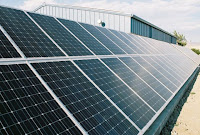 If you are planning to mount your home solar power systems on the roof, you need to gain access to the roof to check its suitability.
If you are planning to mount your home solar power systems on the roof, you need to gain access to the roof to check its suitability.Use a compass to check which direction the roof slopes in. If it is not directly facing south, you may need to construct an angled support in order to get the panels angled correctly.
You will need to find out the pitch of the roof in degrees. Professionals use a tool called a roof angle finder to calculate this. Roof Angle Finders (sometimes called Magnetic Polycast Protractors) are low cost tools available from Builders Merchants. You press the angle finder up against the rafters underneath the roof and the angle finder will show the angle in degrees.
Alternatively, you can calculate the angle using a protractor at the base of a roof rafter underneath the roof itself.
Solar panels in themselves are not heavy – a 15-20 kilograms at most – but when multiple panels are combined with a frame – especially if that frame is angled – the overall weight can become quite significant.
Check underneath the roof to see the structure and to ensure that it is strong enough to take the solar array and to ascertain what fixings you will need. It is difficult to provide general advice on this point as there are so many different designs of roof it is not possible for me to provide suitable general information in this book. If you are not certain about the suitability of your roof, ask a builder or an architect to assess your roof for you.
Roof mounting kits are available from solar panels suppliers. Alternatively, you can make your own. Learning how to build a solar panel isn't really a difficult task only if you know how to.
If it does not compromise your solar design, it can be quite useful to mount your solar panels at the lowest part of the roof. This can make it considerably easier to keep the panels clean: most window cleaners will a happily wash easily accessible solar panels if they are situated at the bottom of the roof, and telescopic window cleaner kits are available to reach solar panels at the lower end of a roof structure.
Measure and record the overall roof-space available for a solar array. It is also a good idea to use your cardboard cut-outs you made earlier and place these on the roof to give a ‘look and feel’ for the installation and help you identify any installation issues you may have with positioning and mounting your DIY solar panel.
Useful information home solar power systems:
http://ezinearticles.com/?Home-Solar-Power-Systems-Uses&id=3547988
Learn how to DIY solar panels:
http://ezinearticles.com/?Get-the-Information-Necessary-to-Construct-a-DIY-Solar-Panel&id=4088827









No comments:
Post a Comment